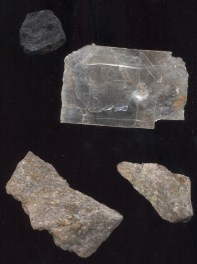 This unit includes:
This unit includes:
Triboluminescence is the property of emitting light when struck or rubbed. A well-known example of a triboluminescent material, not mentioned in the booklet for this unit, is WintOGreen Lifesavers; the sugar crystals in these candies triboluminesce mainly in the ultraviolet range, and the wintergreen oil fluoresces in the blue range when excited by the ultraviolet emitted by the sugar.
The booklet mentions that the triboluminescent properties of mica were not well known or understood at the time, and this still appears to be true. Most mica does not exhibit triboluminescence, so the phlogopite specimen in this unit is quite unusual in doing so.
A fascinating example of serendipity in scientific research related to this subject was reported recently. To study triboluminescence in mica, researchers at UCLA constructed an apparatus that used adhesive tape to separate layers of mica. They rediscovered tribolumninescence in adhesive tape, first reported in 1939, and observed that when tape is peeled in a near-vacuum, it emits X-rays as well as visible light (a discovery first reported by Soviet researchers in 1953). Remarkably, the intensity of the emitted X-rays is sufficient to allow imaging of the bones in a finger, for example, as the researchers show in a supplement to their paper ( Camara, Escobar, et. al., Nature 455:1089-1092, October 2008). This phenomenon (still not well-understood) may lead some day to the development of portable diagnostic imagers that do not require a high-voltage apparatus to generate X-rays.
Production by Ruby Yoshioka.